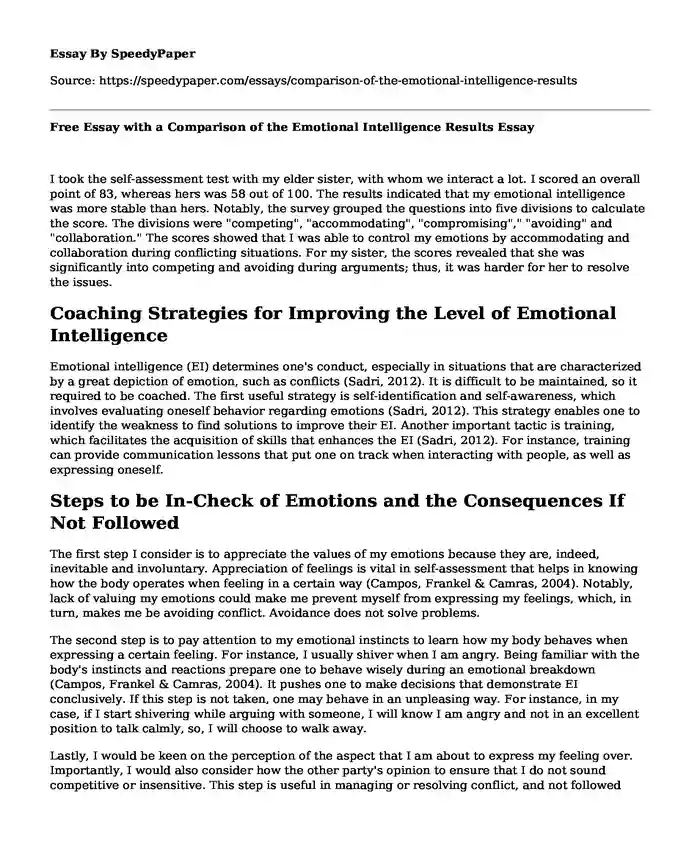
| Type of paper: | Course work |
| Categories: | Emotional intelligence |
| Pages: | 3 |
| Wordcount: | 769 words |
I took the self-assessment test with my elder sister, with whom we interact a lot. I scored an overall point of 83, whereas hers was 58 out of 100. The results indicated that my emotional intelligence was more stable than hers. Notably, the survey grouped the questions into five divisions to calculate the score. The divisions were "competing", "accommodating", "compromising"," "avoiding" and "collaboration." The scores showed that I was able to control my emotions by accommodating and collaboration during conflicting situations. For my sister, the scores revealed that she was significantly into competing and avoiding during arguments; thus, it was harder for her to resolve the issues.
Coaching Strategies for Improving the Level of Emotional Intelligence
Emotional intelligence (EI) determines one's conduct, especially in situations that are characterized by a great depiction of emotion, such as conflicts (Sadri, 2012). It is difficult to be maintained, so it required to be coached. The first useful strategy is self-identification and self-awareness, which involves evaluating oneself behavior regarding emotions (Sadri, 2012). This strategy enables one to identify the weakness to find solutions to improve their EI. Another important tactic is training, which facilitates the acquisition of skills that enhances the EI (Sadri, 2012). For instance, training can provide communication lessons that put one on track when interacting with people, as well as expressing oneself.
Steps to be In-Check of Emotions and the Consequences If Not Followed
The first step I consider is to appreciate the values of my emotions because they are, indeed, inevitable and involuntary. Appreciation of feelings is vital in self-assessment that helps in knowing how the body operates when feeling in a certain way (Campos, Frankel & Camras, 2004). Notably, lack of valuing my emotions could make me prevent myself from expressing my feelings, which, in turn, makes me be avoiding conflict. Avoidance does not solve problems.
The second step is to pay attention to my emotional instincts to learn how my body behaves when expressing a certain feeling. For instance, I usually shiver when I am angry. Being familiar with the body's instincts and reactions prepare one to behave wisely during an emotional breakdown (Campos, Frankel & Camras, 2004). It pushes one to make decisions that demonstrate EI conclusively. If this step is not taken, one may behave in an unpleasing way. For instance, in my case, if I start shivering while arguing with someone, I will know I am angry and not in an excellent position to talk calmly, so, I will choose to walk away.
Lastly, I would be keen on the perception of the aspect that I am about to express my feeling over. Importantly, I would also consider how the other party's opinion to ensure that I do not sound competitive or insensitive. This step is useful in managing or resolving conflict, and not followed people may end up behaving wrongly.
Ways of Ensuring the Emotional State is Appropriate when Interacting with Clients.
Clients are delicate stakeholders in a business setting and require to be treated with respect. However, on some occasions, employees fail to address them as expected, especially when they are unable to control their emotions when wronged or hurt. That's why they need to ensure that their emotional state is stable when interacting with customers (Grandey, 2000).
One way to achieve this quality is to listen keenly to what the client wants and ensure that he/she is served per the request. Notably, listening reduces the worker's tendency to care for his/her emotions; thus, he/she manages to fulfill the customer's needs (Grandey, 2000). Another critical method is to study each customer to understand their behavior and preferences. Studying, in this case, involves knowing the client's identity details, which may either be physical or psychological (Bechtoldt, 2011). For instance, one can identify a Muslim woman by noticing her Hijab. This tactic enables the employee to understand and embraces the customers' diversities by allowing him/her to tailor a message that is convenient for each (Bechtoldt, 2011).
References
Bechtoldt, M. N., Rohrmann, S., De Pater, I. E., & Beersma, B. (2011). The primacy of perceiving: Emotion recognition buffers the negative effects of emotional labor. Journal of Applied Psychology, 96(5), 1087. Retrieved from https://psycnet.apa.org/record/2011-10092-001
Campos, J. J., Frankel, C. B., & Camras, L. (2004). On the nature of emotion regulation. Child Development, 75(2), 377-394. Retrieved from https://srcd.onlinelibrary.wiley.com/doi/abs/10.1111/j.1467-8624.2004.00681.x
Grandey, A. A. (2000). Emotional regulation in the workplace: A new way to conceptualize emotional labor. Journal of Occupational Health Psychology, 5(1), 95. Retrieved from https://psycnet.apa.org/buy/1999-15533-009
Sadri, G. (2012). Emotional intelligence and leadership development. Public Personnel Management, 41(3), 535-548. Retrieved from https://journals.sagepub.com/doi/abs/10.1177/009102601204100308
Cite this page
Free Essay with a Comparison of the Emotional Intelligence Results. (2022, Feb 24). Retrieved from https://speedypaper.net/essays/comparison-of-the-emotional-intelligence-results
Request Removal
If you are the original author of this essay and no longer wish to have it published on the SpeedyPaper website, please click below to request its removal:
- Gun Control Essay Example, Free to Use
- Free Essay on Ways in which Television Distorts Children's Perception of Reality
- Free Essay Sample on American Presidential Elections
- Essay Example on Obesity in Teenagers
- The Mexican Ancestry, Essay Example for Students
- Essay Sample Dedicated to Venice Boats
- Essay Example on Lord of the Flies and the Most Dangerous Game
Popular categories




